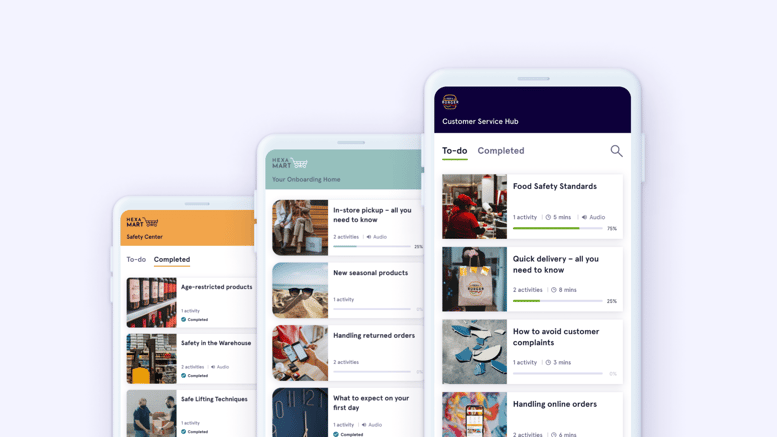Is SCORM Dead?: The Future of SCORM and SCORM Alternatives
TABLE OF CONTENTS
The learning technology industry has come a long way since the arrival of SCORM in 2000.
Initially created as an innovative way to ensure content compatibility across all Learning Management Systems (LMS), the technology has since lagged behind.
While new solutions have enabled the creation of adaptive, flexible and user-friendly training content, SCORM remains trapped in the age of static, one-way learning.
So why is SCORM still a must-have for so many learning and development teams? Is there a better way to deliver training to the modern worker?
In this blog, we’re diving into the history of SCORM technology, the pros and cons of using it in your training program, and whether it’s time to put it aside.
Quick navigation:
- What is SCORM, and why was it created?
- Is SCORM still relevant?
- Advantages and disadvantages of SCORM
- Why do L&D teams still use SCORM?
- What are the alternatives to SCORM?
.png?width=777&height=437&name=SCORM%20Blog%20(1).png)
What is SCORM, and why was it created?
Sharable Content Object Reference Model (SCORM) is a set of technical standards for eLearning software products. It essentially works as a wrapper which allows training content to be grouped together into one package and used across multiple LMS’.
When online learning emerged in the 1990s, the lack of an agreed structure led to compatibility issues and a lack of consistency throughout the industry. Each piece of content had to be adapted for a specific LMS and couldn’t easily be transferred to another, which was costing businesses a lot of time and money.
The arrival of SCORM created an agreed set of standards for all LMS’, enabling cross-platform compatibility and reporting.
Is SCORM still relevant?
Though SCORM is still used by some L&D teams today, many would argue that it’s becoming a hindrance, rather than a solution.
The technology was developed twenty years ago, before the dawn of smartphones and social media, but has since failed to adapt with the times. While most digital content has moved to HTML5, SCORM still relies heavily on technologies which are falling out of use (and are incompatible with mobile). Because it’s so expensive to update thousands of existing courses, most of these modules still look the same as they did in the early 2000s - i.e. pretty outdated..png?width=1920&height=1080&name=SCORM%20Blog%20(2).png) It’s not just the technological sphere that’s changed, however. Thanks to social media, today’s learners are used to the short, snappy and interactive content they consume via their newsfeeds. While other learning technologies have begun to replicate these behaviors and have adapted their content for ever-lessening attention spans, SCORM-style content remains the same - which makes engaging younger employees even more of a challenge.
It’s not just the technological sphere that’s changed, however. Thanks to social media, today’s learners are used to the short, snappy and interactive content they consume via their newsfeeds. While other learning technologies have begun to replicate these behaviors and have adapted their content for ever-lessening attention spans, SCORM-style content remains the same - which makes engaging younger employees even more of a challenge.
Some professionals may argue that courses must be SCORM-compliant to be hosted on an LMS, but this is actually a common misconception. If you don’t need to move the course out of the LMS, making it compliant with a set of standards like SCORM is unnecessary and not cost-effective.
So, is SCORM still relevant? It’s certainly old and not the optimal format for engaging the modern workforce, but it still seems to have a firm grip on much of the learning and development community.
Advantages and disadvantages of SCORM
Let’s take a look at some of the pros and cons of SCORM to understand why it’s still a requirement for some, and an immediate eye-roll for others.
Advantages
Brings training into a common environment
With SCORM, training modules can be integrated from different sources into a common environment. This means you’re able to create a course and use it multiple times in different formats using the same LMS.
Compatibility with other LMS'
One of the main pros among L&D teams is that content is compatible across all SCORM-compliant LMSs - i.e. you’re able to transfer your training from one delivery system to another without any issues (as long as SCORM is supported on both, of course).
Ability to buy ready-made content
Another reason many professionals still seek out SCORM-style training is the ability to purchase off-the-shelf content that’s immediately ready to deploy to their workforce.
Disadvantages
Reporting is limited
If we can’t track a learner’s full behavior, we can’t report on it. SCORM only enables L&D teams to access data on specific types of behavior such as progress and completion rates - not the impact that the training is having on their performance.
Course creation is slow and expensive
Whereas newer formats are more user-friendly and agile, SCORM content is notoriously time-consuming to create. It often requires a third party authoring tool outside of your LMS which means more money spent, and more training for your admins.
Difficulty in updating courses
SCORM modules can only be updated as a unit, meaning that if you need to change messaging, update with a new policy or even fix a typo, you’ll have to reupload the entire package. Depending on your provider, this sometimes means that any progress made by learners on that specific course will be lost as they’ll be using the new package next time.
Reliance on off-the-shelf content
Though many view the availability of off-the-shelf content as a plus, the over reliance on ready-made content which is so often linked with SCORM usage leads to training programs that feel impersonal and generic. Training that isn’t relevant or adapted to your workforce is less likely to engage them.
SCORM is a technical standard that is over two decades old - since then, learning design principles have evolved from an older, more linear learning approach, to reflect the modern learner. With a need for more UX-focused learning experiences today, SCORM limits the capability of the admin to create those and to report data in newer and more detailed ways.
- Sam Gauci, Senior Learning Designer at eduMe
Passive learning experience
Because it still relies on outdated training formats, SCORM is often criticized as a static, one-way exchange which provides little opportunity for interaction. This results in a passive learning experience, which is damaging for learner engagement and retention. Though some SCORM-compliant LMS’ have tried to bring quizzes and assessments into their platform, newer learning tech vendors are still lightyears ahead with features such as immersive video feedback and VR.
Not optimized for education
Despite being such a central component of the eLearning industry, SCORM-based content actually fails to address several key requirement for effective training - it’s not bite-size, it’s rarely personalized to the learner’s own experience, and often lacks interactive features such as quizzes to reinforce knowledge and promote retention.
Built for desktop
While some (but not all) SCORM packages will work on mobile, they weren’t designed for these devices. Traditional LMS’ and their features were created with the desk-based worker in mind, and don’t provide the seamless mobile experience that modern employees have become accustomed to.

Why do L&D teams still use SCORM?
Despite the considerably long list of cons, SCORM is still a non-negotiable for many businesses when building their employee training programs. But why?
In a survey by Software Advice, 150 corporate LMS users shared their top reasons for doing so:
- It’s compatible with their LMS (32%)
- It’s the standard they’ve always used (28%)
- Technical stability (17%)
The results above confirm what many in the industry already suspected - that most learning and development teams put up with SCORM purely out of habit, despite its many problems and the wealth of better solutions available.
There’s also the fact that switching to a learning provider that isn’t SCORM-compliant will likely reveal the holes in existing training content. Continuing to rely on SCORM means avoiding a complete overhaul of learning modules and courses, even if it’s necessary.
When sharing her companies’ experience of migrating their LMS to SCORM 2004, Amy Rouse explains that the success of the initiative was short-lived - soon their employees were “sick of content that looked the same, was difficult to access, boring, and too lengthy”. She came to the realization that SCORM would not meet the needs of their current and future workforce.
The biggest learning from her experience, however, was that traditional learning metrics and approaches were no longer serving them.
L&D leaders are finally beginning to grasp that learning activity does not necessarily predict business outcomes, therefore the 20-year-old metrics of course completions, scores and “smile sheets” do not tell the full story of the impact of learning.
- Amy Rouse
As the learning industry continues to develop, it’s becoming increasingly more clear that the most successful training is that which produces real business results. Remaining stuck in the age of SCORM packages and eLearning modules is limiting businesses, keeping them focused on completion rates and assessment scores rather than the metrics which actually impact their bottom line.

What are the alternatives to SCORM?
In order to make better investments and reap the full rewards that training has to offer, businesses need to move away from the traditional ways of doing things.
Training technologies like eduMe (that’s us!) have been built for the modern learner and for usage on smartphone devices, replicating the bitesize content that they consume on social media for an experience that’s more familiar and more engaging than standard eLearning.
Our solution is also designed to be more accessible for workers on-the-go. By eliminating log-in screens and unnecessary, meandering journeys, we provide seamless one-tap access to training within the tools workers are already using. This method of delivery, entirely unique to eduMe, has been shown to increase engagement with training by up to 300%.
In contrast to SCORM-based content, you don’t need to use an external authoring tool to create or modify content. All courses can be made within the eduMe platform and delivered to learners in a matter of minutes, ensuring that your workforce is always kept up to date with the latest information.
Better yet, we also provide real-time reporting within eduMe, giving you full visibility of the performance of your training and enabling you to measure real business impact. These are just some of the results our customers have seen since implementing eduMe:
- 70% reduction in time-to-productivity
- 66% increase in sales
- 26% reduction in injuries
- 506% return on investment
Want to watch a short video on how eduMe works? fill in the form below to see a pre-recorded demonstration 👇
Join 10,000+ frontline leaders
Subscribe to ‘Training the Frontline’ and get weekly insights sent straight to your inbox.


